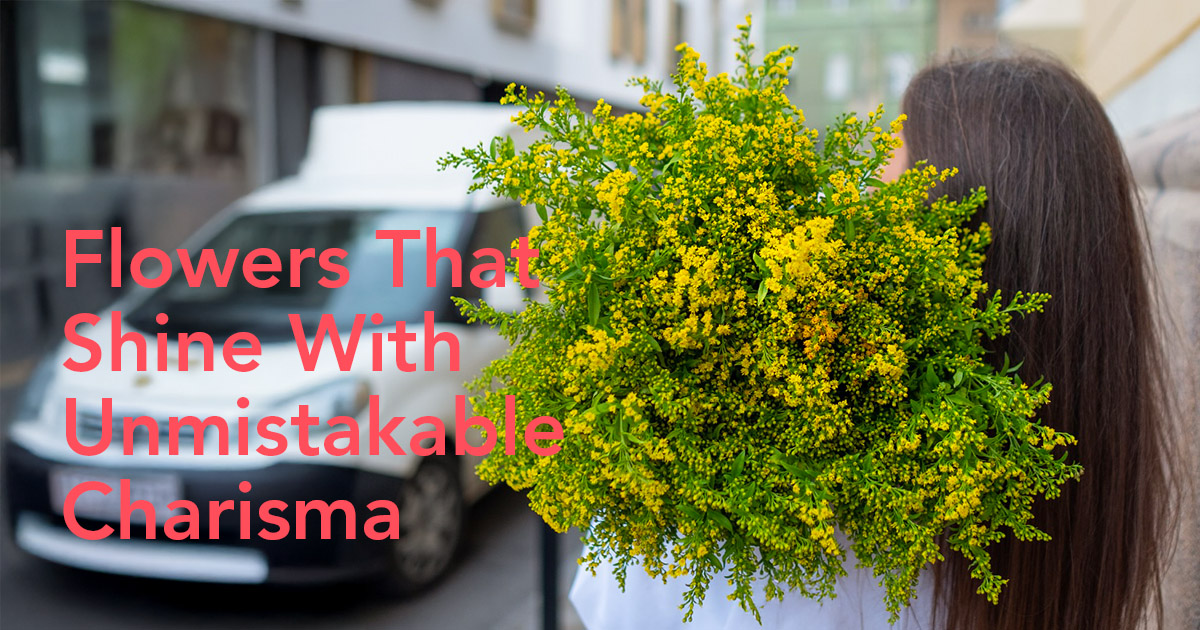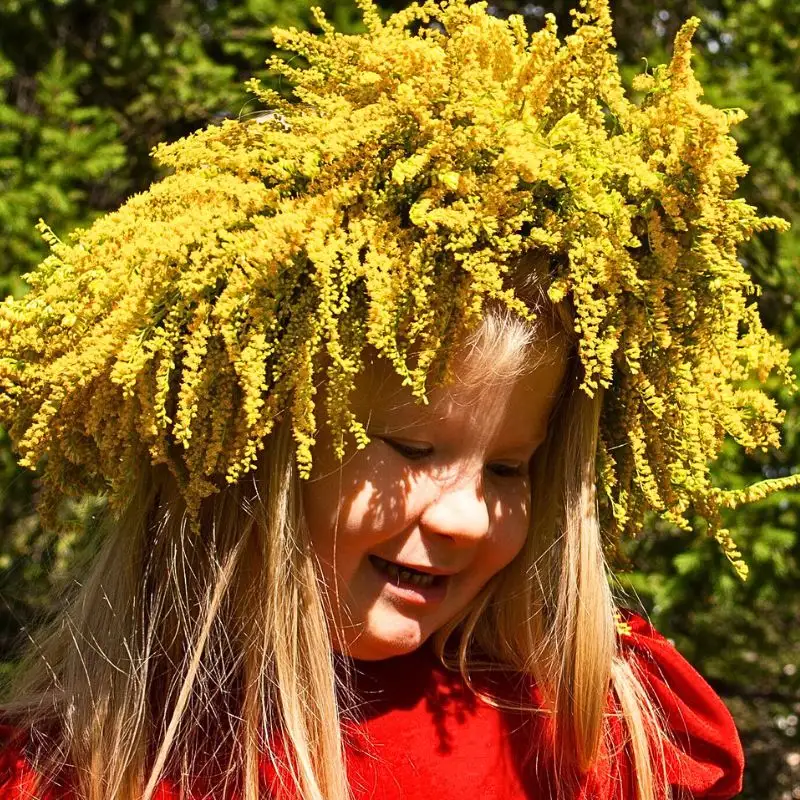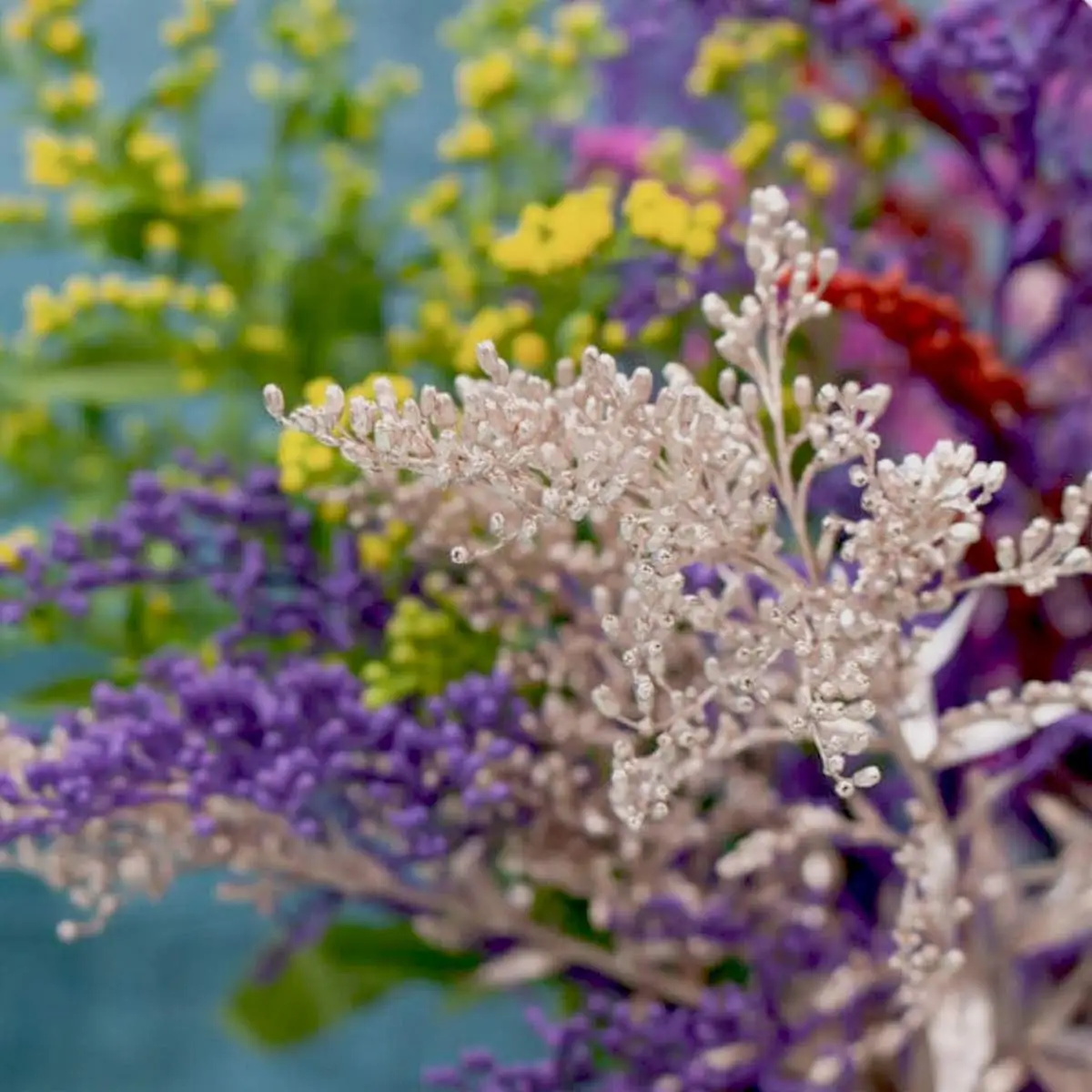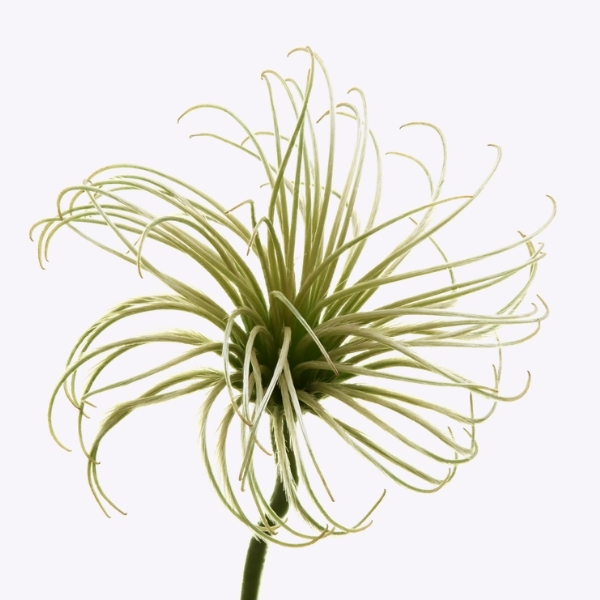Solidago flowers’ flaring plume is more than a late‑season splash of color; it is a living chronicle of medicine, myth, gastronomy, industry, and aesthetics. From prairie fire to patent laboratory, from liberty‑steeped teacup to Dickinson’s notebook, goldenrod flower meaning threads its influence through every niche of human ingenuity. In the pages ahead, we will glide from botanical fact to folkloric lore, tasting, testing, and arranging a flower that has quietly underwritten well‑being, prosperity, and inspiration on three continents.
A Gilded First Glance at the Solidago Canadensis
Solidago belongs to the vast Aster family yet shines with unmistakable charisma: more than 120 recognized species carpet the North American continent, while intrepid cousins flourish in the Andes, Siberia, and the Balkans. Rhizomatous roots anchor spear‑straight stems topped by clusters of tiny florets that open sequentially from midsummer through hard frost. Their hue ranges from lemon chiffon to burnished topaz, depending on soil pH and daylight length. Botanists cite solido—Latin for 'to make whole'—as etymological evidence of its classical therapeutic repute.

Although urban legends still accuse goldenrod of instigating hay fever, palynologists have proved its pollen is sticky, insect‑transported, and rarely airborne; pollen is windborne, unlike Solidago's heavy pollen. The true culprit is ragweed, whose inconspicuous green flowers release billions of dust‑fine grains on the same autumn breeze. Ragweed, which blooms around the same time as Solidago, is responsible for triggering seasonal allergies due to its windborne pollen.
Myth, Meaning & Mettle: Goldenrod’s Symbolic Ledger
In the emblematic lexicon of Victorian floriography, presenting a tuft of goldenrod implied that fortune was already en route, the botanical equivalent of a telegram reading “Good news imminent.” Solidago has historically been known to symbolize good fortune, growth, and encouragement. In East Asian feng‑shui practice, dried stems are positioned in the Xun sector—the wealth corner—to amplify prosperity, while Brazilians knot fresh inflorescences above the doorway to invite joy and shoo away melancholy.
Yet prosperity is only half the story; resilience is the flower’s second signature. A stalk bent by prairie winds rebounds unbroken, shimmering like a miniature standard of defiance. For this reason, Solidago appears in graduation bouquets, recovery wreaths, and corporate milestone arrangements—quietly broadcasting optimism undergirded by grit. It embodies sincerity, growth, and encouragement, making it a symbol of goodwill and the ability to thrive in challenging conditions.
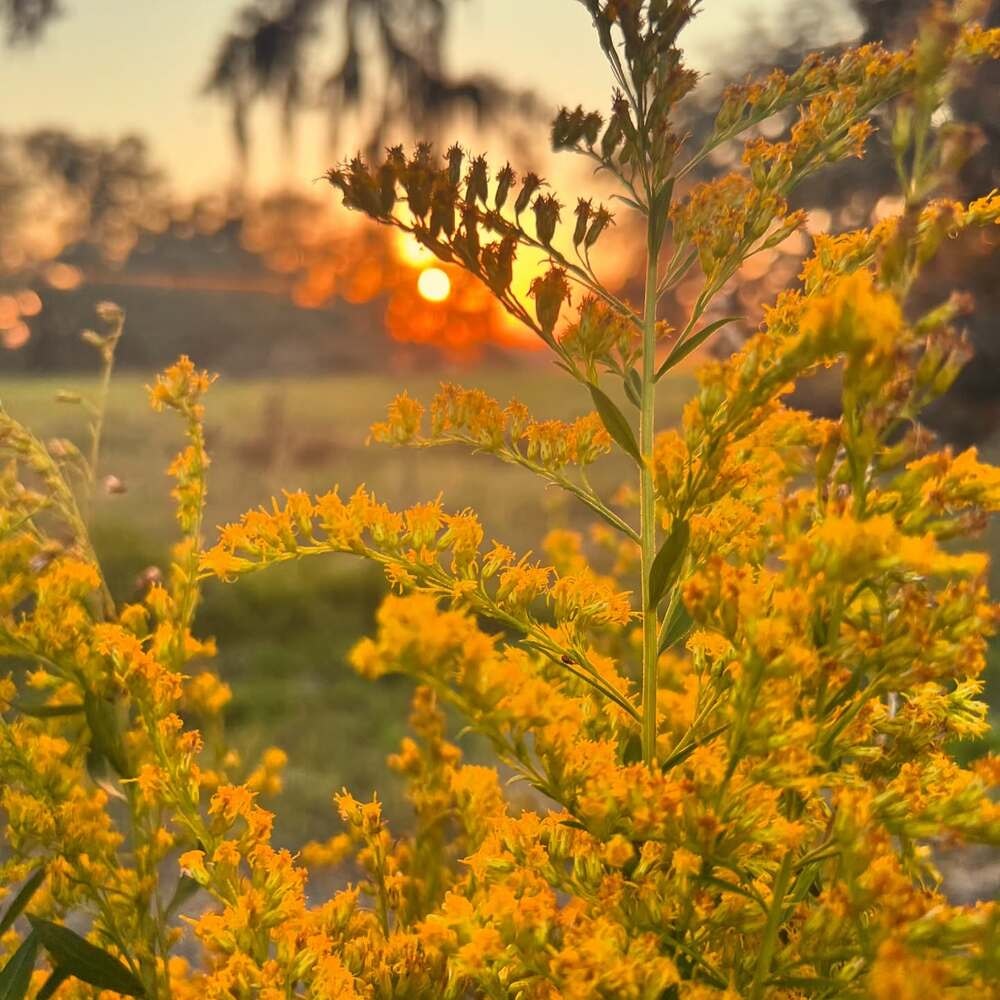
Legends in Bloom: Folk Traditions From Wigwam to Wattle‑and‑Daub
Goldenrod has served as diviner, dye‑pot, aphrodisiac, and guardian herb, its gilded torches illuminating ceremonies from Algonquin corn dances to Celtic well‑blessings and Bavarian Erntedank processions. Native Americans also chewed the leaves of Solidago to relieve toothaches and sore throats, highlighting its traditional medicinal uses.
Cherokee midwives combined blossoms with river birch bark to create medicines to treat wounds, internal bleeding, and other ailments. Algonquin hunters rubbed crushed florets into moccasins to mask human scent and chewed the leaves to relieve toothaches and sore throats.

Indigenous North American Wisdom: Native to North America
Haudenosaunee healers brewed leaf infusions with maple sap to restore wan appetites after winter lean times, while Meskwaki mothers sweetened goldenrod teas to coax toddlers into articulate chatter, believing the plant carried the spirit of eloquence. Cherokee midwives combined blossoms with river birch bark as a febrifuge for postpartum women; Algonquin hunters rubbed crushed florets into moccasins, trusting the resinous scent would mask human pheromones and baffle deer.
In the Great Plains, Lakota artisans simmered petals with buffalo-tallow mordant to yield a steadfast yellow‑ochre dye that adorned quillwork and tipi canvases, outlasting decades of prairie sun.

European & Colonial Lore
Medieval leech‑books enumerated 'wound‑wort' (S. virgaurea) among the revered Nine‑Herb Charm, prescribing it for lancing spears and arrow gashes. In the British Isles, water‑diviners cut Y‑shaped goldenrod rods during waxing moons, confident the stems would tremble above hidden aquifers or seams of tin.
Elizabethan apothecaries marketed Consolida Saracenica—a goldenrod salve for sword cuts—at triple the cost of comfrey. Across the Atlantic, post‑Revolutionary colonists brewed “Liberty Tea,” blending Solidago leaves with spearmint, thus thumbing their noses at taxed British imports. The drink’s earthy sweetness still lingers in New England farmhouse traditions each Patriots’ Day.

Nowadays, Grown on a Large Scale in Kenya
When it comes to growing Solidago cut flowers nowadays, big names that keep popping up are breeders like Danziger, and growers like Marginpar—and for good reason. Marginpar's Kenyan farms, like KS Farm near Rongai and ST Farm close to Sobea, are key players in producing the Solidago Carzan Glory variety. These farms sit at altitudes around 1,900 meters, offering just the right conditions for growing strong, full stems with a good vase life.
Their approach combines sustainable practices with a focus on soil health, biodiversity, and efficient water use, ensuring that each stem of Solidago Carzan Glory meets high standards. For florists seeking reliable, high-quality Solidago, Marginpar's Kenyan-grown Carzan Glory offers a consistent and sustainable choice.

Pharmacy of Gold: Modern Science Behind Ancient Cures and Plants' Healing Properties
High‑performance liquid chromatography outlines a treasury of quercetin, kaempferol, chlorogenic acid, germacrene‑D, and triterpenoid saponins—compounds that ratify centuries of empirical use. In vitro studies show ethanolic extracts curb Staphylococcus aureus, E. coli, and Candida albicans, while German double‑blind trials report a 35 % reduction in interstitial cystitis flare‑ups after eight weeks of goldenrod tincture. Clinical phytotherapists prize the plant for “flushing therapy,” leveraging its diuretic potency to hasten kidney‑stone passage without electrolyte imbalance.
Solidago has also been historically used to treat wounds and internal bleeding. Meanwhile, oncology researchers are probing Solidago polysaccharides for immune‑modulating potential in adjunct cancer care, highlighting the flower’s future in biomedicine. Native Americans chewed the plant's leaves to help relieve toothaches and sore throats, showcasing its diverse therapeutic applications.
- Anti‑inflammatory: downregulates cyclo‑oxygenase‑2 and NF‑κB pathways.
- Antimicrobial: aldehydes and flavonoids perforate bacterial cell walls.
- Antioxidant: radical‑scavenging activity rivals green tea catechins.
- Diuretic: increases renal blood flow by 12 % without sodium loss.

Meadow‑to‑Table Gastronomy: Culinary Adventures With Solidago Altissima
At dawn, when terpenes peak, snap florets for kitchen alchemy: fold them into artisanal butter and watch it soften into sunrise on sourdough. In the Smoky Mountains, grandmothers still bottle “sunshine jelly,” a solar infusion of petals, apple pectin, and lemon zest that glows like topaz and tastes faintly of anise‑tinged honey. The edible flowers and leaves can also be used to make tea, salads, and soups, showcasing their versatility and nutritional value.
Chefs at Copenhagen’s NOMA riff on that heritage by fermenting goldenrod tips with koji rice, then blending the result into a plant‑based umami paste. For an unforgettable canapé, tempura‑batter entire racemes, sprinkle with smoked sea salt, and pair with thirty‑month Manchego; the crisp shell cracks to release floral sweetness that dances against savory depth.

Clearing the Air: Literally & Figuratively
Goldenrod’s sticky pollen clings to bee pelts, not bronchioles, exonerating the plant from hay‑fever allegations. Its pollen is carried by insect couriers, not the wind. Ecologists at the University of Toronto discovered that Solidago’s phyllosphere hosts methylotrophic bacteria able to degrade tropospheric ozone and volatile organic compounds by twelve percent along urban roadways.
Meanwhile, entomologists note that late‑season nectar sustains monarchs, sulphur butterflies, and twenty‑seven species of specialist native bees, effectively knitting biological corridors across fragmented cityscapes, whose pollen is heavier. By planting a patch of goldenrod, gardeners add a final, breath‑cleansing chapter to the photosynthetic saga—a floral air‑filter humming with life when most flowers have shut down for the year.

Edison’s Green Rubber Dream
In 1927, Thomas Edison, alarmed by America’s dependence on Southeast Asian rubber, joined Henry Ford and Harvey Firestone in a million‑dollar quest for domestic latex. Scouring Florida pine‑barrens, Edison settled on Solidago leavenworthii, coaxing hybrids that soared three metres high and delivered latex yields above ten percent. His Fort Myers laboratory fashioned prototype Model‑T tyres that reportedly withstood 1,200 miles of gravel track.

Although World War II ushered in cheap synthetics, advancements in manufacturing eventually led to the adoption of synthetic rubber for more efficient production in the automotive industry. Edison’s verdant experiment remains a milestone in bio‑industrial research, prefiguring today’s interest in guayule and Russian dandelion as green rubber alternatives. In a curious twist, archived lab notes reveal Edison also explored goldenrod‑derived antioxidants for prolonging tire life—yet another way the plant was poised to keep America rolling.

A Golden Thread Through Poetry & Paint: Solidago in Literature & Art
Emily Dickinson tucked 'the head of golden‑rod' into thirty poems, calling it August’s trumpet and winter’s harbinger. Robert Frost staged contemplative walks amid 'tall golden‑rod' in A Boy’s Will, meditating on roads not taken. Mary Oliver compared its blaze to 'an electric leash for the sun', while contemporary poet Ross Gay names it 'the long‑lasting note in the meadow’s gospel choir'.
Visual artists likewise succumb: William Morris immortalised its silhouette in Arts‑and‑Crafts wallpaper, Claude Monet dabbed goldenrod in La Prairie, and contemporary floral designer Azuma Makoto once bronze‑cast an entire raceme for his 'Frozen Flowers' series—proof that Solidago bridges word, pigment, and installation. The 'language of flowers' further enriches its cultural significance, symbolizing good fortune and encouragement.
And do not forget Maggie Smith, who published a collection of poems titled 'Goldenrod' about the beauty in the things we see and do every day.

Goldenrod Flower Tattoo & Its Meaning
Beyond mere adornment, a goldenrod tattoo announces perseverance welded to luminous hope. Wearers often entwine stems with compasses, crescents, or semicolons, amplifying their guidance narrative: find treasure, navigate darkness, continue the story. The goldenrod flower also symbolizes good fortune, sincerity, adding layers of meaning to its depiction.
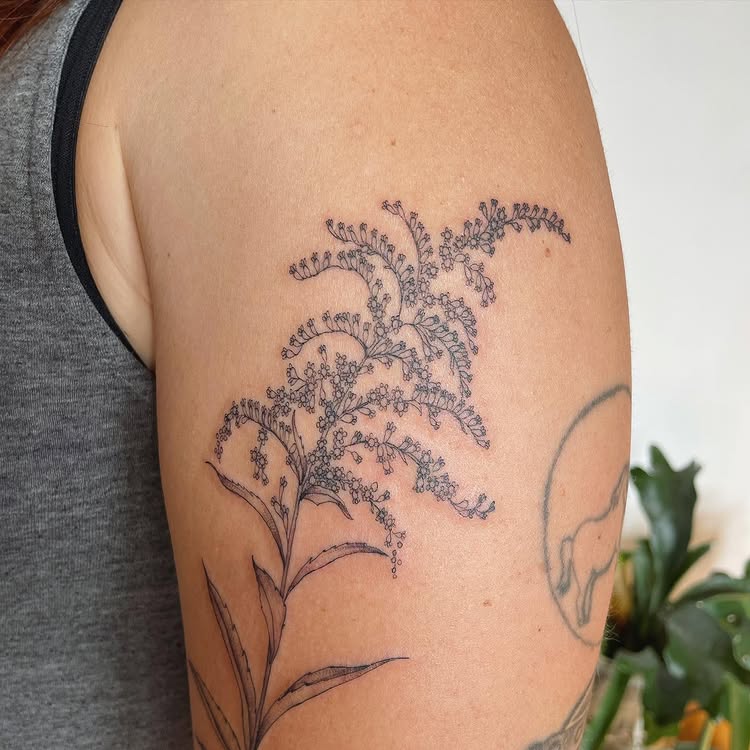
In minimalist blackwork, a single uprooted plume reminds its host that authentic growth begins unseen, rhizomatic, before it erupts into gold. Neo‑traditional artists overlay florets in mandala halos to signify abundance radiating outward, while color‑realism stylists capture the variegated saffron of sun‑kissed petals to celebrate triumph over adversity.
Planting & Caring for Your Solidago
Select a sun‑bathed site with lean, free‑draining soil; overly rich beds produce floppy stems. Layer two inches of compost each spring around the thick crowns or rhizomes, and shear spent inflorescences to extend bloom by four weeks. Divide clumps every third year to keep vigour high and territorial zeal in check. This practice also helps manage the vast array of cultivars, ensuring a diverse and vibrant garden display.

Light Requirements for Solidago
A minimum of six hours’ direct light intensifies pigment and nectar concentration. In zones 9–10, a veil of afternoon shade guards against leaf scorch and prolongs the tensile strength of stems.
Watering Needs for Solidago
Once established, goldenrod revels in mild drought, yet weekly deep soaks yield plumper panicles. Mulch lightly with pine needles to conserve moisture, acidify soil, and discourage encroaching weeds.
Feeding & Maintaining Solidago
Avoid high‑nitrogen feed; instead, top‑dress with slow‑release organic pellets or leaf mould. Stake cultivars exceeding 1.5 metres with willow hoops before midsummer squalls. Regularly snap off lateral buds to channel energy into a fireworks finale.
Propagating Your Solidago
For seed propagation, cold‑stratify for thirty days at 4 °C, then surface‑sow and mist until cotyledons appear. Division is simpler: slice rhizomes just as buds blush green in early spring, replanting 30 centimetres apart to forestall empire‑building. Solidago grows from crowns or rhizomes, typically, which allows it to reach significant heights and develop distinct floral structures. Cuttings from softwood tips root readily in perlite‑rich medium under 60 % humidity.
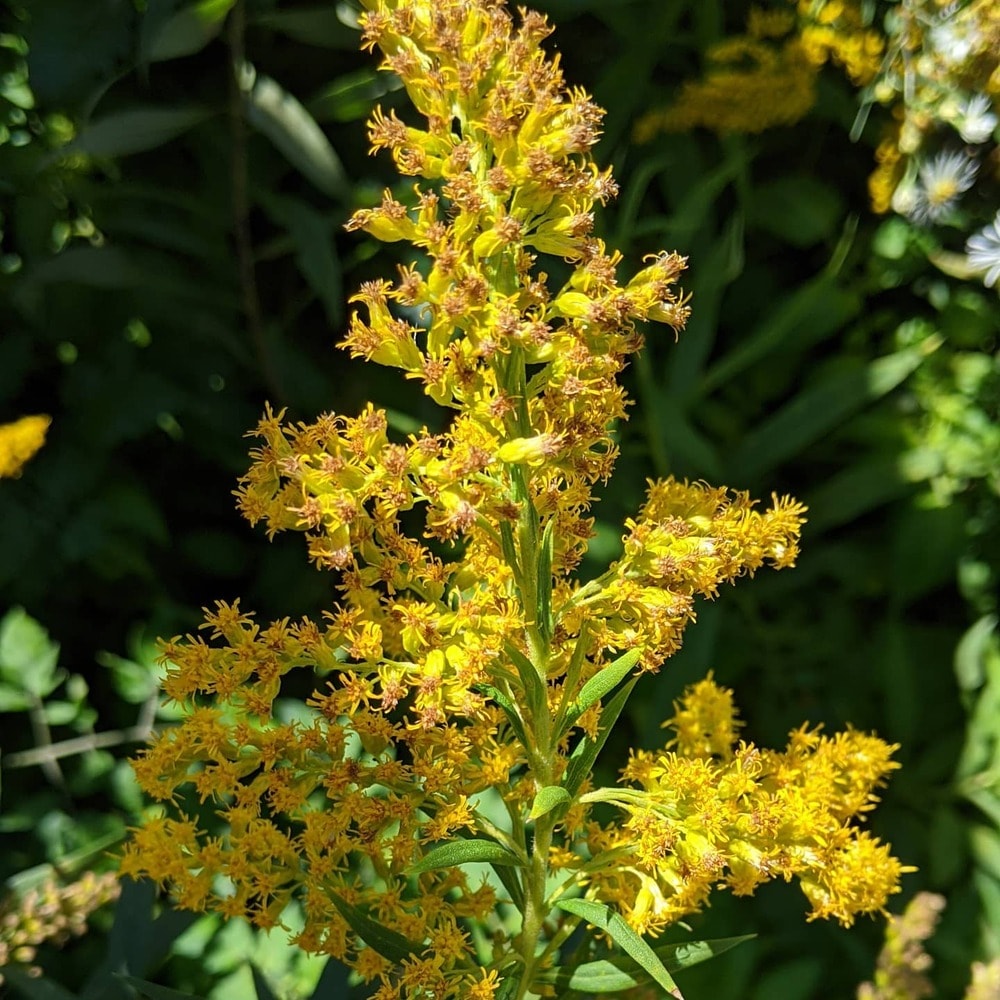
Managing Pests & Diseases in Your Solidago
Aphids crowd tender tips; a forceful water jet or ladybird release restores equilibrium. Powdery mildew thrives in stagnant air—thin stems, increase spacing, and dust with micronized sulfur at the first ghostly bloom. Thick clusters of tiny florets on Solidago stems can also contribute to stagnant air, so ensure proper spacing. Leaf miners rarely threaten vigour, but cosmetic damage can be clipped away before exhibition bouquets.
Goldenrod’s Golden Touch: Solidago in Contemporary Floristry
Modern designers exalt goldenrod’s frothy texture as a luminous filler flower providing wonderful volume, weaving it through rose globes, pairing it with indigo delphinium, or letting it star solo in monochrome sculptural arrangements. In foam‑free installs, its water‑wicking stems serve as living girders, propping heavier blooms while adding rhythmic sparks of ochre. Dried plumes retain color for months, anchoring autumn wreaths and avant‑garde chandeliers sprayed gilt for banquet halls. This flower, which provides wonderful volume, is popular among florists for both fresh and dried floral designs. High‑end event studios tint blossoms with interference pigments, transforming a humble wildflower into iridescent garlands that shimmer like comet tails under gallery spotlights.

Where Sunlight Finds Its Echo
To seed a patch of goldenrod is to cultivate optimism in tangible form—medicine for human bodies, a banquet for pollinators, a pigment palette for artists, and a metaphor for souls negotiating adversity. Long after summer’s flashy annuals retire, Solidago keeps the biosphere humming, gilding meadows with the promise that endings are merely sunlight seeking a new angle.
With its origins in the meadows of North America, Solidago embodies resilience and adaptability, symbolizing good fortune and pioneering spirit. In that golden afterglow, the prairie repeats its whispered truth until frost finally hushes the chorus: resilience glitters brightest when other colors fade.

